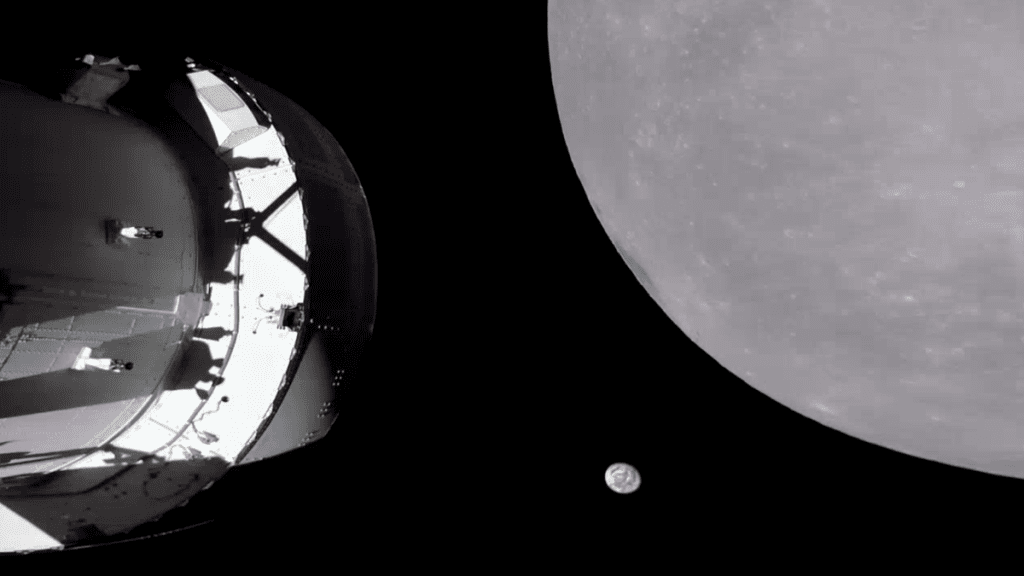Artemis I Passes 81 Miles Above Moon's Surface Before Heading for Record-Breaking Distance from Earth

The Earth is seen setting from the far side of the Moon just beyond the Orion spacecraft in this video taken on the sixth day of the Artemis I mission by a camera on the tip of one of Orion’s solar arrays. The spacecraft was preparing for the Outbound Powered Flyby maneuver which would bring it within 80 miles of the lunar surface, the closest approach of the uncrewed Artemis I mission, before moving into a distant retrograde orbit around the Moon. The spacecraft entered the lunar sphere of influence Sunday, Nov. 20, making the Moon, instead of Earth, the main gravitational force acting on the spacecraft.Image: NASA
Much like the James Webb Space Telescope, it took scientists and engineers years and multiple launch attempts to get the Artemis I SLS rocket and its Orion spacecraft up in the air. After four launch attempts over two months, the most powerful rocket ever built by NASA successfully launched just last week. Good things are now coming to those who waited: The mission is going swimmingly, and soon the spacecraft will be farther from Earth than any other vehicle meant to carry human beings has ever reached.
On Monday, Orion passed just 81 miles above the Moon’s surface while traveling at 2,128 mph. So close, yet so far away. A burn pushed that speed up to 5,102 mph as the spacecraft made its way over the previous landing sites of Apollo 11, 12 and 14, according to NASA. Here are a few more facts and figures to completely blow your mind:
Orion will travel about 57,287 miles beyond the Moon at its farthest point from the Moon on Nov. 25, pass the record set by Apollo 13 for the farthest distance traveled by a spacecraft designed for humans at 248,655 miles from Earth on Saturday, Nov. 26, and reach its maximum distance from Earth of 268,552 miles Monday, Nov. 28.
As of Monday, Nov. 21, a total of 3,715.7 pounds of propellant has been used, 76.2 pounds less than prelaunch expected values. There are 2,112.2 pounds of margin available over what is planned for use during the mission, an increase of 201.7 pounds from prelaunch expected values.
Just after 2:45 p.m. CST on Nov. 21, Orion had traveled 216,842 miles from Earth and was 13,444 miles from the Moon, cruising at 3,489 miles per hour.
The Artemis I mission is the unmanned first step back to the moon for the U.S. It’ll spend about 25 days doing a few loops around the moon before returning to Earth. The Orion spacecraft and new spacesuits onboard will be pushed to the very limits while over a quarter of a million miles away from Earth. The next step, Artemis II, is slated from sometime in 2025 and will involve a four-person crewed flight around the moon and will take human beings the farthest into space ever. By 2026, we could have boots on the as yet unexplored lunar South Pole.
Image: NASA
G/O Media may get a commission
The goal of the Artemis missions aren’t just a chance revisit the Moon, but to set up a permanent lunar base in orbit which will allow astronauts to spend weeks or even months exploring the Moon as well as serve as a launch point for further exploration of our solar system.
Despite early SNAFUs which delayed launches in August, September and October Orion program manager Howard Hu told reporters Monday that the Artemis 1 flight “…continues to operate exceptionally,” from the New York Times:
Except for minor glitches — Mike Sarafin, the Artemis mission manager, called them “funnies” — the Artemis I flight has proceeded smoothly. The funnies included Orion’s star trackers being momentarily confused when the spacecraft’s thrusters fired.
“We are on flight day six of a 26-day mission,” Mr. Sarafin said on Monday, “so I would give it a cautiously optimistic A+.”
The flyby exercised the major piece of Artemis that is not American. The parts of the Space Launch rocket were built by Boeing, Northrop Grumman and the United Launch Alliance while the Orion capsule itself was built by Lockheed Martin.
However, the service module — the part of Orion below the capsule that houses the thrusters, solar arrays, communications equipment and other supplies — was built by Airbus, and was one of the contributions by the European Space Agency to the Artemis program. The module will not return to Earth, but instead will be jettisoned to burn up in the atmosphere shortly before the capsule splashes down.
The Orion spacecraft is expected to return to Earth Dec. 11 by splashing down in the Pacific Ocean off the coast of California.



